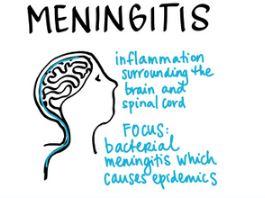Overview
Meningitis: Symptoms and Treatment- For the diagnosis of meningitis is necessary the study of cerebrospinal fluid, which is extracted by a lumbar puncture. It should be done as soon as possible if there are no contraindications.In some cases, the lumbar puncture is postponed until a neuroimaging test ( CT or brain magnetic resonance ) is obtained.
The cerebrospinal fluid examination allows identifying the causative agent of meningitis in the majority of patients.
Other complementary samples that can help with the diagnosis are blood cultures, otorhinopharyngeal samples or stool samples (particularly if enterovirus is suspected).

Meningitis: Symptoms and Treatment more info
LEARN MORE ABOUT MENINGITIS
Meningitis is inflammation of the membranes that line the brain (meninges) and the fluid that occupies the space between them (cerebrospinal fluid), which usually has an infectious cause.Any germ that infects the body can cause meningitis. Viral meningitis, caused by viruses, is benign. The most frequent and most serious are those of bacterial origin.
Pneumococcus and meningococcus are the bacteria responsible for more than half of acute meningitis in our country.
- Read Also:
Measles (Sarampión) Treatment Symptoms
Measles vaccine: starts vaccination campaign against measles
Meningitis Symptoms
The symptoms common to any type of meningitis are headache, fever, nausea, vomiting and neck stiffness.This rigidity consists of the resistance of the cervical musculature to the active or passive flexion of the head, associated with local pain. It can also be accompanied by an altered level of consciousness, seizures and other neurological symptoms and signs.
In young children, the only clinical manifestations can be apathy, crying and rejection of food. The elderly can present the only alteration of the level of consciousness, without fever or neck stiffness.
Although some symptoms suggest the cause of the infection, such as the presence of a rash in meningococcal, the responsible agent cannot be deduced from the clinical data.
What are the most common symptoms?
HeadacheFeverSicknessVomitingStiff neckTreatment of a meningitis
Bacterial meningitis is a medical emergency. Since the patient's defenses are little or nothing effective in controlling the infection, the elimination of the microorganisms will depend exclusively on antibiotic treatment. Therefore, in acute bacterial meningitis, antibiotic treatment must be instituted immediately.The type of antibiotic chosen to treat meningitis will depend on the bacteria that causes the infection. As this disease is very serious, you can not wait for the results of cerebrospinal fluid culture, which can take days. This is why antibiotic treatment is usually established according to the bacteria that is most likely causing the condition, based on the age of the patient. The most used antibiotics in bacterial meningitis are the third generation cephalosporins since they cover most of the microorganisms that cause this picture. Once the bacteria that caused the infection is known, a more specific antibiotic is administered.
In many cases, in addition to antibiotics, it is necessary to administer treatments for the cerebral edema that occurs, for seizures or for dehydration. Corticosteroids are useful for reducing cerebral edema and it has been shown that, especially in children, the number of complications decreases.
If fluid has accumulated between the meninges, it may be necessary to drain or remove it surgically.

